
About UsThe Numismatic Bibliomania Society is a non-profit organization devoted to the study and enjoyment of numismatic literature. For more information please see our web site at coinbooks.org SubscriptionsThose wishing to become new E-Sylum subscribers (or wishing to Unsubscribe) can go to the following web page link MembershipThere is a membership application available on the web site Membership Application To join, print the application and return it with your check to the address printed on the application. Membership is only $20 to addresses in the U.S., $25 for First Class mail, and $30 elsewhere. For those without web access, write to: David M. Sundman, Treasurer
AsylumFor Asylum mailing address changes and other membership questions, contact David at this email address: dsundman@LittletonCoin.com SubmissionsTo submit items for publication in The E-Sylum, just Reply to this message, or write to the Editor at this address: whomren@gmail.com BUY THE BOOK BEFORE THE COIN |
- WAYNE'S WORDS: THE E-SYLUM JANUARY 4, 2015
- KOLBE & FANNING NEW YORK SALE CLOSES JANUARY 10, 2015
- NEW BOOK: WORLD PAPER MONEY, GENERAL ISSUES, 15TH ED.
- NEW BOOK: THOMAS JEFFERSON AND HIS DECIMALS
- WALTER O. WOODS: THE STORY OF UNCLE SAM'S MONEY
- COIN IMAGES SOUGHT FOR BOWERS PROJECTS
- PARTRICK 1792 CHALLENGE UPDATE
- NUMISMATIC ITEMS, SMALL AND LARGE
- NOTES FROM E-SYLUM READERS: JANUARY 4, 2015
- ELDER MONTHLY, VOL. 2, NO. 1 SOUGHT
- RICKETTS'S CIRCUS TOKEN BUYERS SOUGHT
- WHEN ALUMINUM COINS WERE STRUCK
- THE NUMISMATIC SCRAPBOOK CONTRIBUTOR MEDAL
- FEDERAL RESERVE BANKER WILLIAM MCCHESNEY MARTIN JR.
- THE RECIDIVIST’S FIRST COLLECTIONS
- OSCAR PEARL AND ABE KOSOFF
- REED HAWN’S 1993 COLLECTION
- ELONGATED COIN COLLECTOR SALLY KIRKA
- ROYAL MINT MAKES BIG BEN £100 COIN
- THE ROYAL MINT'S MAGNA CARTA COIN
- FAMILIES TO REUNITE WWI SOLDERS' MEDALS
- THE DEFINITION OF SIDEROGRAPHY
- DEFINITIONS OF COIN, MEDAL. TOKEN, COUNTERFEIT
- THE MEDALLIC WORK OF CHARLES CUSHING WRIGHT
- THE MISSING MISSOURI GOLD SALES TAX TOKENS
- ARE ISIS COINS BEING MINTED IN CHINA?
- THE FUTURE OF CUBAN NUMISMATICS
- NORMAN COIN HOARD UNCOVERED IN BUCKINGHAMSHIRE
- ISRAEL RECOVERS 800 STOLEN ANCIENT COINS
- THE SPECIFIC GRAVITY TEST FOR COPPER, BRONZE, AND BRASS
- MORE ON THE ANTICHRISTIAN CONFEDERACY
- GOLD TEETH DROPPED IN SALVATION ARMY KETTLE
- FEATURED WEB SITE: CUBAN NUMISMATIC ASSOCIATION
Click here to access the complete archive
To comment or submit articles, reply to whomren@gmail.com
WAYNE'S WORDS: THE E-SYLUM JANUARY 4, 2015

New subscribers this week include: Jesse Gingold and Harry Spielberg. Welcome aboard! We now have 1,803 subscribers.
This week we open with a reminder about Kolbe & Fanning New York numismatic literature sale, one new book and a discussion of an old one by a Treasurer of the United States.
Other topics include the smallest and largest numismatic items, The Elder Monthly, Ricketts's Circus tokens, John W. Adams, Oscar Pearl, Abe Kosoff, Reed Hawn, Charles Cushing Wright, and King Ethelred the Unready.
To learn more about Thomas Jefferson and his decimals, Tom Elder's paperweight , Walter O. Woods and Uncle Sam's Money, Victor Bishop's aluminum, uncut sheets of French assignats, Big Ben, the Magna Carta, and a pelican medal, read on. Have a great week, everyone!
Wayne Homren
Editor, The E-Sylum
KOLBE & FANNING NEW YORK SALE CLOSES JANUARY 10, 2015
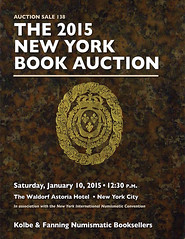 Kolbe
& Fanning Numismatic Booksellers are holding their annual New York Book Auction this Saturday, January 10, beginning at 12:30 p.m. Eastern Time.
The public auction sale of rare and important numismatic literature is being held in conjunction with the 2015 New York International Numismatic
Convention (NYINC) at the Waldorf-Astoria Hotel in New York City. The sale will take place in the Norse Suite, on the 18th Floor of the hotel. Live
online bidding will be available through the Kolbe & Fanning online bidding portal (managed by iCollector) at auction.numislit.com.
Kolbe
& Fanning Numismatic Booksellers are holding their annual New York Book Auction this Saturday, January 10, beginning at 12:30 p.m. Eastern Time.
The public auction sale of rare and important numismatic literature is being held in conjunction with the 2015 New York International Numismatic
Convention (NYINC) at the Waldorf-Astoria Hotel in New York City. The sale will take place in the Norse Suite, on the 18th Floor of the hotel. Live
online bidding will be available through the Kolbe & Fanning online bidding portal (managed by iCollector) at auction.numislit.com.
The sale features outstanding numismatic works covering ancient, medieval, modern foreign and United States coins and medals. The 2015 sale is especially strong in classic books on post-Renaissance European coins and medals and United States numismatic rarities.
Printed catalogues were mailed in early December to active clients. A PDF of the catalogue is available for downloading from the Kolbe & Fanning website at www.numislit.com. Live and absentee internet bidding is available through auction.numislit.com, on which site every lot is illustrated in color. Bidders planning to participate online are strongly encouraged to register in advance.
As Kolbe & Fanning staff will be traveling to New York, absentee bids must be received in their Ohio office by Monday, January 5. To place absentee bids after that date, please email David Fanning at df@numislit.com or call him at (614) 256-8915. Absentee bids cannot be accepted on the day of the sale except through the live online platform. For more information, see the Kolbe & Fanning website at www.numislit.com.
David F. Fanning, Ph.D.
Kolbe & Fanning Numismatic Booksellers LLC
141 W. Johnstown Rd.
Gahanna, OH 43230
(614) 414-0855
Cell (614) 256-8915
Fax (614) 414-0860
df@numislit.com
www.numislit.com
Members ANA, ANS, IAPN
NEW BOOK: WORLD PAPER MONEY, GENERAL ISSUES, 15TH ED.
 The Standard Catalog of World Paper Money, General Issues, 15th edition is now available from
Krause Publications, a division of F+W, a Content + eCommerce company.
The Standard Catalog of World Paper Money, General Issues, 15th edition is now available from
Krause Publications, a division of F+W, a Content + eCommerce company.
Grand in scope and size, the catalog provides everything needed for proper identification and evaluation of world bank notes issued from 1368-1960.
More than 27,500 types and varieties are augmented with 12,000 illustrations.
George S. Cuhaj, editor. 1296 pages, soft cover, list price of $90.00. Stock #T4094. order from your favorite numismatic book supplier or on-line at shopnumismaster.com (Where you may be able to take advantage of some ordering specials).
A DVD of PDFs of the catalog pages will be available shortly.
This edition compliments the Standard Catalog of World Paper Money, Specialized Issues, 12th edition, published in the fall of 2013, and the Standard Catalog of World Paper Money, Modern Issues, 20th edition published in the summer of 2014.
For more information, or to order, see:
Standard Catalog of World Paper Money General
Issues, 1368-1960, 15th Edition (www.shopnumismaster.com/standard-catalog-of-world-paper-money-15th-edition-group)
NEW BOOK: THOMAS JEFFERSON AND HIS DECIMALS
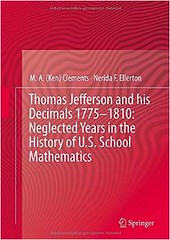 Thomas Jefferson and his Decimals 1775-1810: Neglected Years in the History of U.S. School
Mathematics
Thomas Jefferson and his Decimals 1775-1810: Neglected Years in the History of U.S. School
Mathematics
by M. A. (Ken) Clements, Nerida F. Ellerton
Price: $111.97
Hardcover: 204 pages
Publisher: Springer; 2015 edition (November 19, 2014)
Language: English
ISBN-10: 331902504X
ISBN-13: 978-3319025049
Product Dimensions: 10 x 7 x 0.6 inches
This well-illustrated book, by two established historians of school mathematics, documents Thomas Jefferson’s quest, after 1775, to introduce a form of decimal currency to the fledgling United States of America. The book describes a remarkable study showing how the United States’ decision to adopt a fully decimalized, carefully conceived national currency ultimately had a profound effect on U.S. school mathematics curricula.
The book shows, by analyzing a large set of arithmetic textbooks and an even larger set of handwritten cyphering books, that although most eighteenth- and nineteenth-century authors of arithmetic textbooks included sections on vulgar and decimal fractions, most school students who prepared cyphering books did not study either vulgar or decimal fractions. In other words, author-intended school arithmetic curricula were not matched by teacher-implemented school arithmetic curricula. Amazingly, that state of affairs continued even after the U.S. Mint began minting dollars, cents and dimes in the 1790s.
In U.S. schools between 1775 and 1810 it was often the case that Federal money was studied but decimal fractions were not. That gradually changed during the first century of the formal existence of the United States of America. By contrast, Chapter 6 reports a comparative analysis of data showing that in Great Britain only a minority of eighteenth- and nineteenth-century school students studied decimal fractions. Clements and Ellerton argue that Jefferson’s success in establishing a system of decimalized Federal money had educationally significant effects on implemented school arithmetic curricula in the United States of America.
The lens through which Clements and Ellerton have analyzed their large data sets has been the lag-time theoretical position which they have developed. That theory posits that the time between when an important mathematical “discovery” is made (or a concept is “created”) and when that discovery (or concept) becomes an important part of school mathematics is dependent on mathematical, social, political and economic factors. Thus, lag time varies from region to region, and from nation to nation.
Clements and Ellerton are the first to identify the years after 1775 as the dawn of a new day in U.S. school mathematics—traditionally, historians have argued that nothing in U.S. school mathematics was worthy of serious study until the 1820s. This book emphasizes the importance of the acceptance of decimal currency so far as school mathematics is concerned. It also draws attention to the consequences for school mathematics of the conscious decision of the U.S. Congress not to proceed with Thomas Jefferson’s grand scheme for a system of decimalized weights and measures.
To read the complete article, see:
Thomas Jefferson and his Decimals 1775-1810:
Neglected Years in the History of U.S. School Mathematics (www.amazon.com/Thomas-Jefferson-his-Decimals-1775-1810/dp/331902504X/ref=sr_1_1)
To read the earlier E-Sylm article, see:
LINCOLN CIPHERING BOOK LEAF DISCOVERED (www.coinbooks.org/esylum_v16n25a19.html)

WALTER O. WOODS: THE STORY OF UNCLE SAM'S MONEY
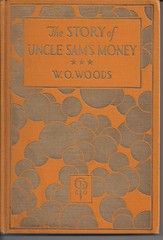 Reading the article on how the "U.S. Recycles Over 90% of Discarded Banknotes" reminded me of something I read in a book that was written
83 years ago. The book is entitled The Story of Uncle Sam's Money and was written by Walter O. Woods. He served as the Register of the
Treasury from 10/1/1927 to 1/17/1929, and Treasurer of the United States from 1/18/1929 to 5/31/1933.
Reading the article on how the "U.S. Recycles Over 90% of Discarded Banknotes" reminded me of something I read in a book that was written
83 years ago. The book is entitled The Story of Uncle Sam's Money and was written by Walter O. Woods. He served as the Register of the
Treasury from 10/1/1927 to 1/17/1929, and Treasurer of the United States from 1/18/1929 to 5/31/1933.
Woods has been the only person who served in two different U.S. Treasury positions. He was very enthusiastic about his job and gave lectures about the Treasury Department. These lectures were so popular, that Woods wrote his book in 1932. It detailed the Treasury Department's activities and responsibilities. In the book, he describes what is done with the "mutilated, worn, and soiled currency". On page 123 he writes:
"The old bills, torn and defaced by constant use, are replaced by the United States Treasury. One method of destruction is by incineration. Another method is to place the bills in macerators, huge cylinders into which chemicals are poured. These chemicals reduce the bills to pulp, which is sold to dealers, who manufacture a number of articles from it, among which are fine imitation-leather bags."
I thought that this was an interesting example of the Treasury Department "going green" over 80 years ago.
Woods refers to small size notes as, "the new small-sized currency," because at the time, the Treasury Department was in the process of switching over from large to small-size notes. When he was Register of the Treasury, he signed mainly large-size notes, and when he was Treasurer of the United States, he signed mainly small-size notes.
There are two exceptions to this. The first is a Series 1928 $1 Silver Certificate Proof Essay (see attached) that Woods signed while he was Register of the Treasury. The actual note was never printed. The second exception are some examples of 1902 Plain Back National Bank Notes that Woods signed while he was Treasurer of the United States. The Silver Certificate Proof Essay image is courtesy of Paul Saylor, President of the Currency Club of Chester County.
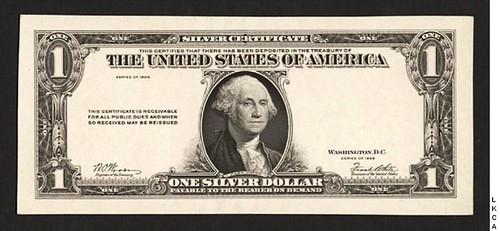
- Prejudice Against $2 Note
- The $10,000 Certificate
- National Bank Notes
- Obsolete and Emergency Currencies
To read the book online, see:
The story of Uncle Sam's money, by Walter O. Woods ...
(http://catalog.hathitrust.org/Record/006565270)
To read the earlier E-Sylum article, see:
U.S. RECYCLES OVER 90% OF DISCARDED BANKNOTES
(www.coinbooks.org/esylum_v17n53a21.html)
THE BOOK BAZARRE
COIN IMAGES SOUGHT FOR BOWERS PROJECTS
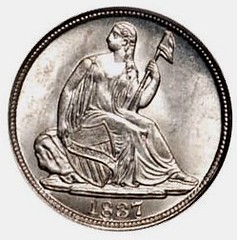

I am in the midst of two manuscripts for Whitman Publishing LLC: A Guide Book of Liberty Seated Coins and A Guide Book of Barber Silver Coins. I have drawn upon research and notes dating back many years.
To illustrate each date, mintmark, and major variety, I welcome hearing from anyone with a file of pictures. I desire high-resolution images of brilliant or lightly toned coins with nice eye appeal and without any certification service tabs intruding into the edges. Credit will be given in the Acknowledgements section to anyone helping. Owners of the coins will have the cachet of having their pieces be “Whitman plate coins” in books that will be widely circulated and for a long time.
Each volume, the Liberty Seated study in particular, will have a lot of interesting and, I hope, very useful information that has never been published in book form before. It is my desire that anyone reading either book will enjoy the experience and gain a comprehensive knowledge of the series from the era of coinage down to modern aspects such as popularity, grading, and market conditions.
A nod goes to the Liberty Seated Coin Club and the Barber Coin Collectors’ Society and their publications as well as to each of the authors who has written specialized books on various series. These are the foundation stones of the field.
The above said, thank you for any ideas, photographs, and other help for the two books. My best wishes for a happy, healthy, prosperous, and numismatically enjoyable New Year.
Dave Bowers
Box 539
Wolfeboro Falls, NH 03896
qdbarchive@metrocast.net
PARTRICK 1792 CHALLENGE UPDATE
Last week Pete Smith wrote:
 I
propose the Partrick 1792 Challenge. Heritage will be selling the Donald G. Partrick 1792 patterns during their FUN auction beginning January 7,
2015. The twelve coins are lots 5501 through 5512.
I
propose the Partrick 1792 Challenge. Heritage will be selling the Donald G. Partrick 1792 patterns during their FUN auction beginning January 7,
2015. The twelve coins are lots 5501 through 5512.
I intend to predict what each of the lots will realize at the sale. I propose to send my predictions to Wayne prior to the sale. I invite anyone else to also submit their estimates to Wayne. Let's go with hammer price to keep it somewhat more simple.
To read the earlier E-Sylum article, see:
THE PARTRICK 1792 CHALLENGE (www.coinbooks.org/esylum_v17n53a14.html)
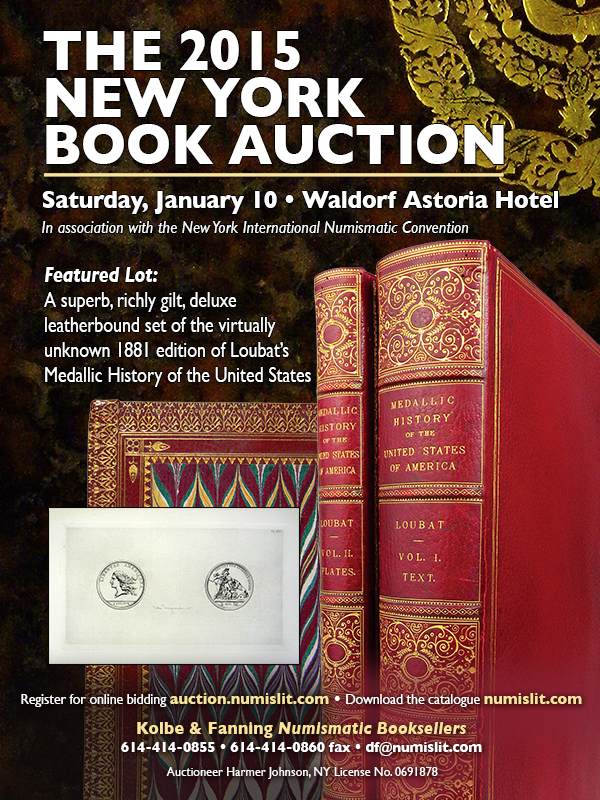
NUMISMATIC ITEMS, SMALL AND LARGE
Last week Dick Johnson wrote:
"So where is the boundary line for what is numismatic? For my databank I have arbitrarily chosen 18 inches as the top size. Anything smaller could be collected by an individual. Anything larger would more than likely be in the collections of institutions."
Martin Purdy writes:
I have a block of Chinese "tea money" that is something like 12 x 10 x 1 inch, so that at least fits within Dick's arbitrary maximum. However, a large spike-like object in our little "ethnographic collection" is getting close to 30 inches in length, which would push the limits out a little further! Not really suitable for a 2x2, album, wallet or even air travel these days. I'm not entirely sure of the attribution of the spike yet. One source suggests West Africa, another Mexico.
 Oh, and at the small end
of the scale, Indian gold fanams, silver chuckrams and copper cash can hover around the 6-7 mm diameter mark.
Oh, and at the small end
of the scale, Indian gold fanams, silver chuckrams and copper cash can hover around the 6-7 mm diameter mark.
I photographed the spike against a tape measure today (about 29.5 inches) and also a little gold fanam, which I left in its 2x2 for comparison. It's about 6mm or 1/4 inch across.

Last week Dick wrote:
"We know the smallest coin, at least struck in America, is the "Panama Pill" the 2 1/2 centesimos with a diameter of 10mm."
David Powell writes:
May I draw your attention to my Lead Token newsletter again, where page 2 of LTT_69 {Jan 2011} describes some strange little pieces, of diameter 8mm and 9½ mm, found in Herefordshire. These are probably as small as anything found in Britain; the normal minimum even for late mediaeval and Elizabethan pewter tokens is only 11mm, with just very occasional specimens falling to 9mm or 10mm.
Other candidates vying for the privilege of smallest coin are some of the 16/17th cent silver pieces of Imperial Russia, described by A.S.Melnikova in "Russian Coins from Ivan the Terrible to Peter I ", the worst of Rome's barbarous radiates and 5th cent minims, and the comparatively modern issues of the Indian state of Travancore. I reckon that the last-mentioned probably win; the smallest Travancore piece in one of my copies of Krause is under 5mm across {c.1809-10}, and even at the beginning of the 20th cent they were still making a few types with diameters of around 9-10mm.
"Under 5mm" feels about the size of a large full stop. How the things were used for any practical purpose, and what the locals thought of them, I cannot imagine.
Introducing the Pb6….
Those of you familiar with the small Roman copper series of the 3rd to 5th centuries may be familiar with the terms AE1 through AE4, used to describe the denominational value of pieces in an era sufficiently obscure that no-one now living has any totally reliable idea of what exactly they were worth. The old well-understood series of sesterius, dupondis, denarius, semis and quadrans had long since gone and, the replacement system of small change being inadequately discussed in literature, we are left to describe copper coin denominations in terms of diameter, as follows:
AE1: >25mm
AE2: 21-25mm
AE3: 17-21mm
AE4: < 17mm
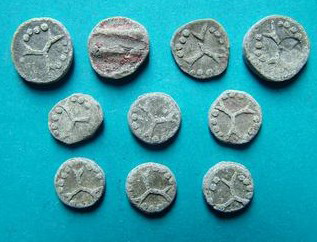

In fact, the scale should probably have been taken one step further, if 4mm bandwidths are assigned as above. The most horrible 5th cent minims and barbarous radiates go down to 11mm frequently and 9mm on occasion, so probably we should have AE4 = 13- 17mm and AE5 = 9-13mm. Our own English 15th and 16th lead hits similar minima, so Pb4 and Pb5 would not be unreasonable, if one were to adopt the same approach; I’m not suggesting we do, I am happy to use diameters. End of issue; surely nobody would be so stupidly impractical enough to go down below 9mm, would they….?
The Indian state of Travancore was notorious for the small size of some of its pieces, the tiniest of which just about hit this figure; one can imagine only the tiny silver slivers of 17th cent Russian kopeks getting close. One looks at them and feels glad not to have lived in a place where such ridiculous things were forced upon the population. Most of the earlier 17th cent main series tokens would be AE4, and they are small enough in the hand; pity our Londoners c.1500 with their Pb5s, but at least we never reached the excesses of Russia and Travancore. Or so I thought until I recently encountered the little group above, which just happen to come from Herefordshire.
They may look large on paper, but in fact the magnification factor is about 1.7; the small ones are around 8mm, the large ones about 9½mm. Probably, the latter are worth twice as much as the former. The design is quite fine and several of them are in moderately good condition, despite the dimensions. The design, a triquetra {three-legged figure} with varying degrees of forking at the end of the arms, is consistent in concept if not always in execution, and the quartet of pellets seems to be invariable. There are never three, never five; which other of our crude lead manufacturers would have been that consistent? In other words, considering their size, they are of a fair standard of manufacture. One wonders how such miniscule proportions would have tested the makers' skills. 8mm, might I say, would be Pb6!
The weights are greater than one might think; the big ones in the sample scale at between 1.13gm and 1.29gm, whilst the seven small ones all lie in the quite compact range of 0.56gm to 0.67gm. Those with a keen eye may also note a counterstamp on the largest one, depicting a plain threelegged cartwheel in miniature. Would you really enjoy using such pieces regularly?
To read the complete January 2011 Leaden Tokens Telegraph issue, see:
www.mernick.org.uk/leadtokens/newsletters/LTT1101.pdf
Ken Spindler of San Diego writes:
Dick Johnson's discussion of the size parameters for "numismatic items" considers only metallic issues. As a part of my collection of 1790s French Revolution money, I collect uncut sheets of French assignats, by type. I own a dozen sheets of different national issues, not counting examples with alternate signature combinations. The largest two measure about 15" x 20-1/2". Also a sheet of watermarked paper - an awfully expensive blank piece of paper! - prepared for a denomination that was authorized but never printed because the new currency system, promesses de mandats territoriaux, failed so quickly; and a printer's proof sheet of a municipal paper money issue, billet de confiance.
I figure they must be about the physically largest collectable numismatic pieces, next to Yap Island stone money or other bulky odd-and-curious with very narrow if any commercial function. Of course it's entirely possible there are even larger uncut sheets of paper currency out there than mine. But not necessarily more interesting; size isn't everything.
To read the earlier E-Sylum article, see:
HOW BIG CAN NUMISMATIC ITEMS BE? (www.coinbooks.org/esylum_v17n53a23.html)
NOTES FROM E-SYLUM READERS: JANUARY 4, 2015
Book Restoration
Harold Levi writes:
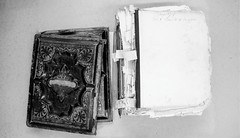 The article about the Ohio Book Store in Cincinnati was very timely. I was
going to ask E-sylum readers for some suggestions about getting a family bible repaired / rebound. The bible I have looks like the one
pictured at the bottom of the article. Thanks!!!
The article about the Ohio Book Store in Cincinnati was very timely. I was
going to ask E-sylum readers for some suggestions about getting a family bible repaired / rebound. The bible I have looks like the one
pictured at the bottom of the article. Thanks!!!
To read the earlier E-Sylum article, see:
THE OHIO BOOK STORE (www.coinbooks.org/esylum_v17n53a24.html)
More On Bert Cohen
Pete Smith writes:
I met Bert Cohen back in the 1980's when I was more active collecting large cents and he was a dealer from Boston. Then I lost touch with him for about 30 years.
A little over a year ago I discovered that he had owned four 1792 coins sold through Dana Linett. I contacted mutual friends and learned that he was still active in the marble business. I contacted him through email and confirmed his ownership of the 1792 patterns.
When I knew him in the 1980's he was a serious collector of items made out of macerated currency. As far as I know, he was the most serious collector at the time, since I didn't know of any other.
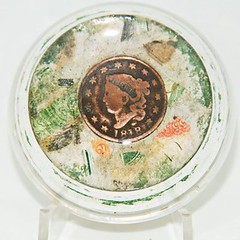

His website had an interesting item that combined his interest in large cents with his interest in macerated currency. It was an 1818 large cent included in a paperweight made of macerated currency. The other numismatic connection is the label on the bottom side. This was an advertising piece for Thomas Elder.
I wonder what happened to Cohen's collection of macerated currency items. Perhaps another E-Sylum reader will know.
To read the earlier E-Sylum article, see:
BERT COHEN, MARBLE COLLECTOR (www.coinbooks.org/esylum_v17n53a08.html)
Shurtleff and Felt
Regarding the 1855 photo of members of the Massachusetts Historical Society, Dave Bowers writes:
I wonder if the pictured Shurtleff (Nathaniel B.) was a numismatist? Augustine Shurtleff, certainly related, was. Joseph Felt’s text, THE FIRST NUMISMATIC BOOK IN AMERICA, is still 99% usable today! Remarkable and nice.
To read the earlier E-Sylum article, see:
PHOTOGRAPH OF JOSEPH B. FELT IN KOLBE & FANNING SALE
(www.coinbooks.org/esylum_v17n53a02.html)

ELDER MONTHLY, VOL. 2, NO. 1 SOUGHT
 I am in possession of a copy of "The Elder Monthly" dated April, 1907, Vol. 2, No. 2. I am not a
numismatist. I picked it up long ago at an antique book store not for its numismatic value, but because it contained an account of the unfortunate
massacre of the Christian Indians at Gnadenhutten, Ohio. I suspect one of my ancestors played a part in that massacre. I found it quite odd to be
published in a magazine devoted to numismatics.
I am in possession of a copy of "The Elder Monthly" dated April, 1907, Vol. 2, No. 2. I am not a
numismatist. I picked it up long ago at an antique book store not for its numismatic value, but because it contained an account of the unfortunate
massacre of the Christian Indians at Gnadenhutten, Ohio. I suspect one of my ancestors played a part in that massacre. I found it quite odd to be
published in a magazine devoted to numismatics.
What I am seeking is the immediate preceding issue. I have not been able to locate one. The issue I have only contains the last part of a series, and states it is a continuation from the previous issue. I have tried to locate the preceding issue(s), but without success. Even a photocopy would do. Can you be of assistance?
RICKETTS'S CIRCUS TOKEN BUYERS SOUGHT

Roger Siboni writes:
I am working on an article about the enigmatic Ricketts's Circus Token and I was wondering if I could once again tap the vast resources of your readership to see if anyone has an annotated named copy of the Woodward May 26, 27, 28 and 29 of 1884 J. T. Levick sale. I have of course tried the ANS and ANA already.
I am specifically looking to see who purchased Lots 1164, 1165, and 1166. As always, many thanks!
For more information on the Ricketts circus, see:
John Bill Ricketts (www.circopedia.org/John_Bill_Ricketts)
WHEN ALUMINUM COINS WERE STRUCK
Dave Lange writes:
 I want to respond to Bruce W. Smith's question of how the U. S. Mint was able to get aluminum
for its pattern coins dated in the 1850s-60s. My suspicion is that these aluminum impressions may have been made later than the dates they carry, a
common enough occurrence during the terms of Director Henry R. Linderman (1867-69 and 1873-78).
I want to respond to Bruce W. Smith's question of how the U. S. Mint was able to get aluminum
for its pattern coins dated in the 1850s-60s. My suspicion is that these aluminum impressions may have been made later than the dates they carry, a
common enough occurrence during the terms of Director Henry R. Linderman (1867-69 and 1873-78).
To the best of my knowledge, the complete aluminum proof sets of 1868 are the earliest aluminum pieces confirmed as being contemporary with the date they carry, and all earlier-dated pieces are subject to being restrikes or novodels. Linderman was a known collector of such rarities.
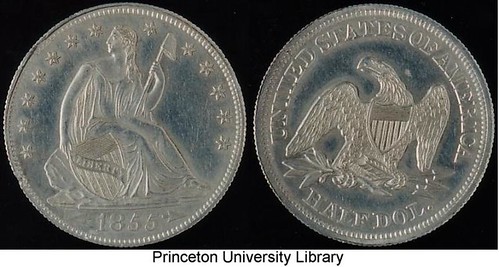
Saul Teichman writes:
With regard to the Judd 175, Bruce notes it as having a plain edge when it clearly has a reeded edge as the image I got from Princeton University clearly shows. As to when it was struck, that is a good question.
As for mention of the 1890 cent, I have never been able to locate one. Regrettably, I do not know where the Mint got its aluminum.
For more information on the Judd 175 pattern, see:
http://uspatterns.com/j175p202.html
John Dannreuther writes:
The earliest record I have for the purchase of Aluminum by the Mint is attached. (This page is courtesy Fred Weinberg, who owns these Mint documents.) Of course, they may have purchased some earlier. From Victor Bishop of New York on Jan. 16, they bought 14 ounces at $2.67 per ounce! I have later purchases, included 50 ounces later for the "bargain" price of $100. Aluminum was more expensive than silver for quite some time.

To read the earlier E-Sylum article, see:
QUERY: WHERE DID THE U.S. MINT GET ALUMINUM?
(www.coinbooks.org/esylum_v17n53a16.html)
THE NUMISMATIC SCRAPBOOK CONTRIBUTOR MEDAL
If you wrote a numismatic article in the 1940s or 1950s and sent it to the Numismatic Scrapbook Magazine chances are it would have gotten published exactly like you wrote it. And if Lee Hewitt felt like it he would send you a medal. No payment for articles - this was a contributor's medal.
The medal was not all that precious. It was small, brass, and one of Osborn Coinage's stock medals of the U.S. presidents. It is the kind of medal like thousands of others that ultimately end up in a dealer's junk box, called a "Loonie Bin" in Canada. (What do they call a junk box in England or Europe?)
But for me that medal was priceless. I had come of age, I was a numismatic author. Lee Hewitt published the first numismatic article I wrote. It was on Missouri Mills. As a 19-year old I was fascinated by the new plastic mills used by Missouri retailers to collect sales tax. One mill for every dollar purchase, I believe. (Later replaced by a bracket schedule as sales tax rates rose so the mills were abolished.)
The one mill denomination tokens were red plastic, five mills were green. They replaced similar size tokens in zinc of the same denominations. I would go to the Missouri Revenue office in Kansas City Missouri and buy quantities of the tokens. They came in boxes of 500, the name on the box was J.W.(?) Wright Manufacturing Co. From that data I wrote my article. (Later I learned the Wright firm was a sales agent not the actual maker.)
However, all through my Air Force and college years I subscribed to the Numismatic Scrapbook. When I graduated from college I traveled to north Chicago to visit Lee Hewitt at his printing plant. I asked him for a job, I wanted to be a numismatic editor. He had no need for one; his operation was pretty lean.
Lee and his brother Cliff had owned a print shop for a number of years. In 1934 he printed a small format pamphlet that became a monthly magazine. As coin collecting became popular in the late 1930s his magazine grew. After World War II it became thick with hundreds of ads.
To maintain his second class mailing permit he had to have 25 percent of editorial matter. As the number of ad pages increased he had to increase the number of editorial pages. It didn't matter too much to Lee. He printed just about anything sent to him.
The magazine was printed letterpress and he had one linotype operator (later this was numismatist Arlie Slabaugh). When an article arrived in the mail Lee would drop it off at his linotype operator who knew instinctively what to do with it -- standard headline and body type. No editing, and few illustrations.
When the magazine was printed Lee had a handful of ladies who inserted them in addressed envelopes. At its height of its circulation, and fat issues, he had as many as thirty ladies working for him for the week the magazine was mailed. He ended up marrying of these as his second wife. (You couldn't do that today with sexual harassment laws. Now an employer would have to say "You're fired; now will you have dinner with me?")
Lee Hewitt and I met often at numismatic conventions. We had similar interests and became fast friends. He taught me a lot about numismatic publishing. He ultimately sold the Scrapbook to Amos Press (Coin World publisher) then retired to Florida. He bought a boat and loved going out on the water. But he couldn't stop going to conventions where we met again and again.
But I cherish the little president medal he gave me for my first numismatic article.
THE BOOK BAZARRE
FEDERAL RESERVE BANKER WILLIAM MCCHESNEY MARTIN JR.
David Ganz writes:
McChesney Martin Jr. served as chairman of the fed for 19 years, 1951 to 1970. The dates quoted in The E-Sylum appear inaccurate; the confusion arises no doubt because of his father, McChesney Martin Sr.
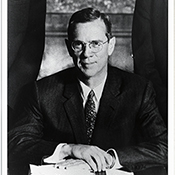 William McChesney Martin Jr. took office as chairman of the Board of Governors of the Federal Reserve System
on April 2, 1951, and served until January 30, 1970. He served under five different presidents.
William McChesney Martin Jr. took office as chairman of the Board of Governors of the Federal Reserve System
on April 2, 1951, and served until January 30, 1970. He served under five different presidents.
Martin was born in St. Louis, Mo., in 1906. He graduated from Yale University with a bachelor’s degree.
Martin’s association with the Federal Reserve was lifelong. His father, William McChesney Martin Sr. helped draft the Federal Reserve Act and was governor of the Federal Reserve Bank of St. Louis from 1929 to 1941. After earning his degree, the younger Martin worked in the bank examination department of the Federal Reserve Bank of St. Louis before leaving to head the statistics department of A.G. Edwards & Sons. He later became the firm’s representative at the New York Stock Exchange. In 1941, he was drafted into the U.S. Army. By the end of World War II, he was a colonel and was nominated by President Harry Truman to lead the Export-Import Bank of the United States.
From February 1949 to April 1951, Martin served as assistant secretary of the Treasury. In that role, he was instrumental in helping negotiate the March 1951 Treasury-Fed Accord. That agreement gave the Fed control over monetary policy and ended its obligation to monetize the debt of the Treasury at a fixed rate. One month after the Accord was signed, President Truman appointed Martin chairman of the Board of Governors.
As chairman, Martin was known for his tight money policies and anti-inflation bias. With his banking background, he emphasized the importance of statistics over economic theory. At the same time, he also pushed for the Fed to have flexibility and discretion in its policymaking. In 1956, he famously described the Fed’s purpose to Congress as “leaning against the winds of deflation or inflation, whichever way they are blowing.”
After leaving the Board of Governors, Martin served on the boards of several corporations and nonprofit organizations, including IBM, American Express and the National Geographic Society. He also worked as a lawyer at Riggs National Bank in Washington.
Martin died in 1998.
To read the complete article, see:
William McChesney Martin Jr.
(www.federalreservehistory.org/People/DetailView/113)
To read the earlier E-Sylum article, see:
NOTES FROM E-SYLUM READERS: DECEMBER 28, 2014 : William McChesney Martin of St. Louis
Fed (www.coinbooks.org/esylum_v17n53a10.html)
THE RECIDIVIST’S FIRST COLLECTIONS
What got me into trouble in the first place was not me. It was my mother. She bought me one of those Lincoln penny albums with holes to be filled for each date and each mint mark. Later, she would say that she did it to keep me from spending money on my friends but, given that I didn’t have any money, I think it was done with malice aforethought. Mother had a great eye for hidden values –she haunted the country antique stores – and she probably wanted to encourage the same curiosity about things in me.
Collection 1 Aged 9 or10 and armed with my Lincoln cent album, I began to pester everyone who came near the house to see their pocket change followed then by regular trips to the bank. Our country bank was really friendly and allowed me to pour over rolls of pennies. When I had measles, chicken pox or general boredom, mother would lug a satchel back and forth to the bank and I would continue my quest for the 1914-D.
After a while, as my Lincoln cents filled in, I bought an Indian cent album – these were the pennies made from 1858 to 1909 before the Lincoln cent was introduced -and, although, there were not that many Indian head cents then in circulation, David Bullowa, a dealer located in Philadelphia just a 40 minute train ride away, sold them for $2 per hundred.
After several such purchases by me, Mr. Bullowa said “Son, you are doing it all wrong. You don’t want to collect quantity, you want to collect quality.”. “What is quality” say I? “These” and he showed me two 1858 Flying Eagle cents in proof, large and small motto. The problem was the price; $92.50 for the pair. The coins were hauntingly beautiful but I didn’t have the money. My new mentor said that’s OK, I will set them aside for when you do.
A year later, I walked back into his shop and, without saying a word, he went to his safe and pulled out the two pieces in question. I paid him but, on the train ride home, felt that I may have been suckered – after all, $92.50 was $92.48 more than face value. Whatever, I had crossed the divide – I was now committed to paying premiums – often large premiums – for coins. Also, I was headed for a complete run of Flying Eagle and Indian head cents in proof, the highest possible condition. I never got there but I did assemble a lovely group of regular issues and proofs plus all twelve pattern cents that the Mint issued in 1858 as different designs for the new cent were being considered. This collection stayed dormant through my college years – years of minimal cash flow – but then, after a brief stint in the Army, my collection became the down payment on a graduate degree in business.
Collection 2 In the late 1960’s, business brought me to New York City on a regular basis. On one trip, on a whim, I looked up coin dealers in Manhattan, with the closest to my hotel being Lester Merkin. Entering his shop, I met the man –an ex-saxophonist turned professional coin dealer - and explained to him where I was on my pilgrimage: I needed a new mountain to climb and he suggested type collecting as something that would really broaden my knowledge of the hobby. After purchasing an 1870-CC half dollar in mint condition, I was off and running but, as matters turned out, I didn’t run very far. In one of his myriad publications, Dave Bowers extolled the allure of large cents and the particular virtues of its specialty club, Early American Coppers. Large cents – large because they are about the size of a quarter – were issued from 1793 to 1857, when the cent was reduced to the token size that we have today. In any event, I joined EAC, the large cent mavens, due to the interest Dave had aroused.
Collection 3 Large cents and the Early American Coppers Club offered me a new dimension in collecting - the social dimension. Previously, I had operated as a lone wolf but now it was altogether different. Meeting, corresponding and chatting with peers opened up for me new vistas on the hobby. With hundreds of peers and with over 300 varieties of early date large cents, I had to start somewhere and that somewhere was to be the year 1794, which was particularly rich in distinctive varieties – some sixty in all.
Coming to realize that the people were as important as the coins, I gravitated to people of the past – the collectors and dealers who had passed along to the modern generation their knowledge and their excitement. Researching and writing about these personalities suggested to me what was then an original insight: provenance (who owned the coin before) was important and, indeed, rather than collect the 60 varieties of 1794 large cents by variety and/or by condition, which is the way it had always been done, why not collect by provenance – i.e. develop a list of the most important collectors of the ‘94’s over the years along with a list of those pieces used to illustrate the early reference works and make these names and images the targets of my collections.
Whereas there was a crowd of people who were interested in 1794 large cents, no one was collecting the collectors – people like Edward Maris, Mortimer MacKenzie, Loren Parmalee and George Clapp. As a further refinement, I added the plate coins from those books dedicated to the varieties of 1794, notably Frossard/Hays (1893) and S.H. Chapman (1926). No one was collecting these plate coins either. Because I made up the rules for my own game, there was no competition for the targets I had set. As a result, I succeeded beyond the dreams of avarice, notching every collector on my list and amassing all but a handful of the Hays and Chapman plate coins that were not locked away in institutions.
To read the earlier E-Sylum article, see:
JOHN W. ADAMS RECEIVES HUNTINGTON AWARD HONOR
(www.coinbooks.org/esylum_v17n18a02.html)
For more information about the American Numismatic Society, see:
www.numismatics.org

OSCAR PEARL AND ABE KOSOFF
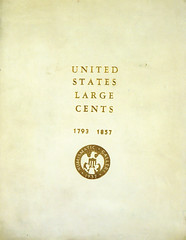 When I worked at Schulman Coin and Mint, mid-1975 (after Hans had left the USA, following his "heart
attack") to January '77 (when the company, in Chapter 11, finally gave up the ghost), an occasional numismatic luminary would stop by. One
was Oscar Pearl. He said he and Kosoff wanted to include a reprint of a catalog of 1793 cents, because it was seldom available. If I'm correct,
Penny Whimsy had not yet appeared, so info on large cents was scarcer, back then. I think Pearl, one way or another, bore the cost of the
extra pages and pictures, as a gift to his fellow collectors. Kosoff, for his part, knew a good deed was often rewarded.
When I worked at Schulman Coin and Mint, mid-1975 (after Hans had left the USA, following his "heart
attack") to January '77 (when the company, in Chapter 11, finally gave up the ghost), an occasional numismatic luminary would stop by. One
was Oscar Pearl. He said he and Kosoff wanted to include a reprint of a catalog of 1793 cents, because it was seldom available. If I'm correct,
Penny Whimsy had not yet appeared, so info on large cents was scarcer, back then. I think Pearl, one way or another, bore the cost of the
extra pages and pictures, as a gift to his fellow collectors. Kosoff, for his part, knew a good deed was often rewarded.
Kosoff certainly was the "friend of widows". He was quoted as telling a colleague:
"You learn the coins. I'll learn the customers." Most of whom had wives, and most of whom were going to have widows.
I recall him dropping in on us at the 57th Street store, graciously visiting an operation that was barely a shadow of its former self. He sat at the counter, sifting in his fingers the coins in a junk box, while chatting with the manager, Gerry Baumann. Gerry liked to joke that Abe pocketed a few worn foreign coppers, but we felt we had been visited by royalty.
Saying goodbye to Abe was a profitable pleasure. After his passing, Bowers & Merena auctioned off his left-over foreign coins, sometimes in large lots that contained the proverbial "junk to gems". I bought my share.
Abe's daughter, Sonny Kliman, sat in the back of the room. Someone we didn't recognize sat across the aisle from her, bidding without apparent knowledge on various lots that opened low. When he was caught with his hand up too long, paying well over $100 each for a lot of restrike Maria Theresia thalers --dated 1780, but brand +new-- Sonny glared at him. So we figured out he was her husband, shill bidding on Abe's coins (her inheritance). No one much minded. The buying was good, if not insanely good, and it felt like we had been transported to a coin auction in the 1940s.
To read the earlier E-Sylum article, see:
SELECTIONS FROM THE KOLBE & FANNING 2015 NEW YORK AUCTION : A Consequential
Misspelling? (www.coinbooks.org/esylum_v17n53a13.html)
REED HAWN’S 1993 COLLECTION
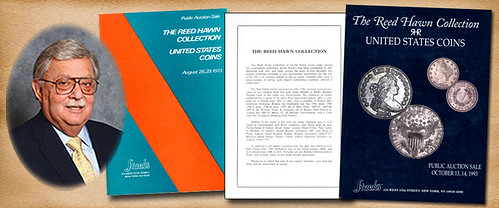
Reed Hawn, who had gained fame as a collector as a result of his major auction sale of 1973, brought to Stack's his newly formed collection of rare coins to sell at public auction. This sale took place in New York at the Park Central Hotel, where Stack’s held many public auctions. The sale dates were October 13 and 14, 1993. Many recalled our earlier sale of Reed Hawn’s items and were anxious to learn what he had accomplished in the ensuing two decades. No one was disappointed and the sale was a landmark sale of the latter part of the 20th century.
As discussed in the description of his earlier collection, Reed was an enthusiastic collector, even in his teenage years, and was seriously pursuing rare coins almost from the first day he started. He began with searching for Lincoln cents from circulation, always replacing poorer examples with better quality when he found it. His father, Bill Hawn, encouraged him by giving him a goloid metric dollar as a present! Reed went out in the 1960s and bought several rolls of Mint State cents, (accumulating rolls was the craze of the period). He selected the best he could find and these could be found in his 1973 and 1993 collections.
His family traveled extensively and in the early 1960s he asked his parents to take him to New York, as he wanted to visit Stack's. It was during that visit that he became friends with Ben, Norman and Harvey Stack. Harvey treasures their friendship to this day, and when Larry joined the firm he too developed a friendship with Mr. Hawn.
At this time, Reed promised the Stack family that if they would help him build an important collection that the firm would have the opportunity to offer it for sale. He kept his word, and the first sale was presented in 1973. It was widely acclaimed to be the "sale of the year" and the results were very rewarding and satisfying to Reed. As related earlier, when the sale was completed, Reed approached the Stacks, expressed his great appreciation and informed them that he was going to try to outdo himself by starting over and building a more exciting collection.
The pride that Reed Hawn has experienced in assembling his collections of coins has been witnessed by the Stack family for the decades we have served the collector and the collection. Studying coins, finding them, acquiring them, and enjoying their ownership is what makes a collector a numismatist. Often a goal is reached, and for that or other personal reasons the decision is made to sell. Then, a numismatist wants to pass on the pleasure of ownership to someone who will experience the same excitement and satisfaction. Some of the collectors we have served stayed within the same series they first assembled. Others, after selling, chose a new specialty such as die varieties or coinage of a time period or area of interest, such as Ancients, coins of Europe, South America or Asia or coins of colonial America.
In Reed Hawn’s 1973 collection, the highlight was his assemblage of U.S. half dollars, from 1794 to 1889. He owned many finest known examples as well as most of the great rarities.
In building his later collection Reed Hawn actually outshone his first efforts by finding rarities, pedigrees and best knowns. He would say that he was learning what the famous assembled before him, what quality and rarity they sought. Reed always said his close relation to Stack's and studying the numerous catalogs they issued, along with those issued by other coin auctioneers, taught him how to build a better collection the second time around.
One of the first great rarities that he bought was the famous Type 1 1804 silver dollar. It happened just around the time he restarted collecting after his sale in 1973. He was talking to my cousin Ben on the phone and asked: "Do you have any rarities for me today?" Ben responded, " We just happen to have the Mickley 1804 Type 1 silver dollar!" Ben heard Reed take a deep breath and then he asked "How Much?" Ben told him. Again there was a deep breath from Reed, after which he said, "I will take it!" After that transaction was completed, Reed told us: "When I call the Stack family, I have to be careful what I ask for, as they often have a great rarity for sale. I had to have the 1804 dollar, as it was going to be the pride of my growing collection."
To read the complete article, see:
The
Incredible Collections of Reed Hawn, Part 5 (www.stacksbowers.com/NewsMedia/Blogs/TabId/780/ArtMID/
2678/ArticleID/64908/The-Incredible-Collections-of-Reed-Hawn-Part-5.aspx)
ELONGATED COIN COLLECTOR SALLY KIRKA
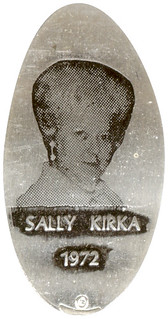 She was the grand dame of elongated cents (EC’s) and wooden nickels. She was the numismatic ambassador from Connecticut. If you’re into EC’s or
wooden money, you know who she was – Sally R. Kirka. She ran her operation out of Manchester, CT, and produced many exciting elongates and various
woods, both flat and round, over a period of about 40 years. She was recognized by numismatic organizations from coast to coast, and was well known
in the collecting community as the Grand Dame of EC’s. Her designs will live on for years and those that are in the hobby currently, or those that
will be entering into the hobby, do and will seek out her creations to add to their own collections. If you collect wood chances are you have at
least one of her woods in your collection. A summery obituary is below:
She was the grand dame of elongated cents (EC’s) and wooden nickels. She was the numismatic ambassador from Connecticut. If you’re into EC’s or
wooden money, you know who she was – Sally R. Kirka. She ran her operation out of Manchester, CT, and produced many exciting elongates and various
woods, both flat and round, over a period of about 40 years. She was recognized by numismatic organizations from coast to coast, and was well known
in the collecting community as the Grand Dame of EC’s. Her designs will live on for years and those that are in the hobby currently, or those that
will be entering into the hobby, do and will seek out her creations to add to their own collections. If you collect wood chances are you have at
least one of her woods in your collection. A summery obituary is below:
Sally R. (Grabowski) Kirka, 83, of Manchester, Connecticut passed away June 5, 2002, after a lengthy illness. She was the widow of Alphonse J. Kirka. She lived most of her life in Manchester – a hot bed of numismatics. Sally served in the Women's Army Corps during World War II. She was an avid coin collector specialized in elongated coins (EC’s) and was the past president of The Elongated Coin Society and was one of the original founding members. She was twice President of the International Organization of Wooden Money Collectors (IOWMC), and a longtime member of Canadian Association of Wooden Money Collectors (CAWMC). She was also active in many local, state and national Numismatic Organizations, including the ANA. She was the editor of three coin publications, NENA News, The Wooden Nickel Club Newsletter and The Elongated Collector (TEC) newsletter. Sally received numerous national Numismatic Awards during her lifetime. Sally was very creative in arts and crafts, specializing in the designing of elongated coins for herself and others.

For more information on The Elongated Collectors, see:
http://tecnews.org/

ROYAL MINT MAKES BIG BEN £100 COIN

A new £100 coin featuring London's Elizabeth Tower which houses Big Ben has been minted to mark the start of the new year.
The Royal Mint in Llantrisant, Rhondda Cynon Taf, has produced 50,000 of the commemorative pieces.
The coins, which contain two ounces (56 grams) of silver, will be available at the face value of £100.
The design was chosen in celebration of Big Ben's distinctive sound, which for many cues the start of the new year.
The coin is expected to prove popular following the sell-out success of the first £20 coin struck in honour of the birth of Prince George.
The design shows the clock tower from street level from the view of a person gazing up towards the sky.
Shane Bissett, the Royal Mint's director of commemorative coin, bullion and medals, said: "The sound of Big Ben chiming in the Elizabeth Tower is one that will have become synonymous with Britain for millions of British citizens and tourists alike, particularly on New Year's Eve when the world listens for Big Ben, which marks Greenwich Mean Time, to chime in the New Year.
"So it is a fitting choice for the nation's first £100 coin, and this is a fitting time for us to reveal it."
While the coins are legal tender, they will not be in general circulation and have been designed as collector items.
David adds:
I am not sure what the design around the coin is meant to be. It looks a bit like a map of the Arctic Circle.
To read the complete article, see:
Royal Mint makes £100 coin featuring Big Ben clock tower
(www.bbc.com/news/uk-wales-south-east-wales-30623562)
To read the earlier E-Sylum articles, see:
ON PERSPECTIVE IN MEDAL DESIGN (www.coinbooks.org/esylum_v17n49a12.html)
JOEL ISKOWITZ ON HIS FALLEN HEROES DESIGN (www.coinbooks.org/esylum_v17n51a15.html)
THE ROYAL MINT'S MAGNA CARTA COIN
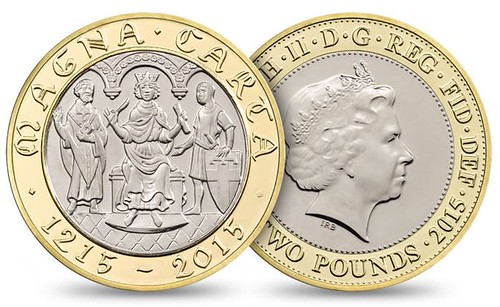
Drawn up some 800 years ago, the Magna Carta was a catalyst for a journey towards freedom for the ordinary man, in the United Kingdom and across the world. We mark this historic moment with a coin struck in celebration of the Magna Carta - the charter of freedoms. This £2 coin with its design by experienced coinage artist John Bergdahl will appeal to collectors and historians across the world wishing to mark this momentous anniversary.
In June 1215 the Magna Carta was agreed by King John, witnessed by barons, noblemen and bishops. It brought an end to the unlimited power of the monarch and signalled a new era where freedom would no longer be out of the grasp of the common man. The Magna Carta has been reinterpreted through time, shaping the constitutions of great nations with some of the clauses still remaining part of British law to this day.
Now you can celebrate the 800th anniversary of this historic document and all that it stands for with a crisply-minted, Brilliant Uncirculated coin struck to commemorate the occasion. Your coin is presented in medieval-inspired packaging that both displays your coin and reveals the story of the Magna Carta and its far-reaching influence across the world and the centuries. Designed by experienced coinage artist, John Bergdahl, this coin makes a great gift for anyone with an interest in history, this significant anniversary or simply an excellent addition to your own growing collection.
David adds:
I think the Magna Carta one is quite a pleasant design. I would be interested to know if other countries will mark this anniversary as well given the world wide significance.
To read the complete article, see:
800th Anniversary of Magna Carta 2015 UK £2 BU
Coin (www.royalmint.com/shop/800th_Anniversary_of_Magna_Carta
_2015_UK_2_pound_BU_Coin)
FAMILIES TO REUNITE WWI SOLDERS' MEDALS

Medal ceremony at Gorse Chateau, France, in February 1918 where nine soldiers were recognised for their actions in the battle of Cambrai, including several from Merseyside- Sgt Cyril Edward Gourley, Victoria Cross, far left. Sgt Edward J. Thornley, Distinguised Conduct Medal, third from left. Bdr Joseph Austin Pinnington, Military Medal, far right. Relatives of Merseyside soldiers recognised for their brave actions during a World War I battle will bring together their medals for the first time since 1918 this month.
The group found each other after Calday Grange Grammar School held an Armistice Day event in November, where a Victoria Cross awarded to former Calday pupil Sgt Cyril Gourley was paraded.
Sgt Gourley was awarded the gallantry medal for showing “unlimited courage” in taking command of a section of guns and keeping advancing German forces in check for four hours during the battle of Cambrai in France on November 30, 1917.
But 11 other Royal Field Artillery soldiers from D Battery of the 276th (West Lancs) Brigade also received medals for their actions on the day, with at least four from Merseyside.
Now family members of three of them – Sgt Edward Thornley, from West Derby, who received the Distinguished Conduct Medal, and Gnr Frederick Backhouse and Bdr Joseph Pinnington, who each received Military Medals – are set to meet along with the son of another soldier, Gnr Reginald Evans, who received a Military Medal.
It comes after Sgt Thornley’s grandson Steve attended the Calday event and met Pat Metcalfe, from Wallasey, daughter of Bdr Pinnington, and her husband Jim.
Mr Thornley, 61, from Spital, said: “It’s been an emotional few weeks.
“I met Pat and it turned out she had her father’s war diary, which detailed how a group of them from Merseyside served together for three years across France, including at the Somme and Ypres. She also had the photo of them being awarded their medals. After that I did some research and tracked down Gnr Backhouse’s son Les in Meols, and Gnr Evans’ grandson Wayne Finch in Cheltenham. We’re all now going to meet up at West Kirby library and bring together the medals.”
Mr Thornley still hopes to trace the relatives of the other seven Royal Artillery soldiers, and believes at least one of them – Bdr Thomas Edge, who received a Distinguished Conduct Medal – is also from Merseyside, as his service number is similar to the other four known Mersey soldiers.
He said: “Their numbers are all within 200 of each other so we think they all enlisted together in Liverpool in September 1915 – and were probably in the same queue.
To read the complete article, see:
Relatives of Mersey World War I heroes to
bring together their medals for first time since they were awarded in 1918
(www.liverpoolecho.co.uk/news/liverpool-news/relatives-mersey-world-war-heroes-8376184)
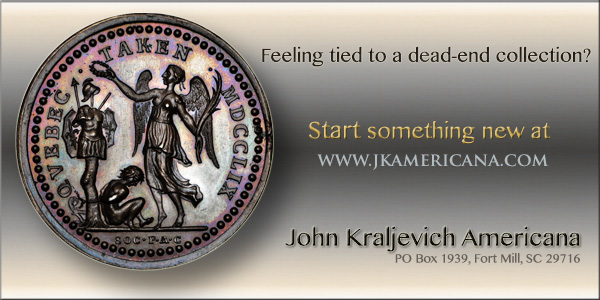
THE DEFINITION OF SIDEROGRAPHY
While it is very kind of David Gladfelter to cite my book for a definition of siderography, there is a definition in the Random House Dictionary of the English Language, Unabridged Edition, 1966:
"1. the art or technique of engraving on metal;
"2. the method of increasing the number of reproductions obtained from a steel engraving by first rolling a soft-steel cylinder over a hardened steel plate and then rolling the hardened cylinder over a soft-steel plate."
It is this second definition that applied to the bank note industry.
 One
other comment on the discussion of siderography. David says in the last paragraph "Interestingly, the term "siderographer" did not
catch on with the artisans themselves." Actually, in 1921, the "Steel Plate Transferrers Association of America" changed its name to
the "International Association of Siderographers." This information comes from their 50th Anniversary commemorative booklet of 1949, the
cover of which shows one of Foringer's allegorical figures looking at a transfer press and the union's name in rather modernistic script (the
cover, which is naturally printed in intaglio, was produced by American Bank Note).
One
other comment on the discussion of siderography. David says in the last paragraph "Interestingly, the term "siderographer" did not
catch on with the artisans themselves." Actually, in 1921, the "Steel Plate Transferrers Association of America" changed its name to
the "International Association of Siderographers." This information comes from their 50th Anniversary commemorative booklet of 1949, the
cover of which shows one of Foringer's allegorical figures looking at a transfer press and the union's name in rather modernistic script (the
cover, which is naturally printed in intaglio, was produced by American Bank Note).
A 1970 membership certificate I have shows the same name.
Siderography lasted for about 150 years, with the photo-etch transfer replacing siderography in the 1980s-early 1990s. And since then the computer has replaced a lot more.
To read the earlier E-Sylum article, see:
ON SIDEROGRAPHIC BANK NOTE PRINTING (www.coinbooks.org/esylum_v17n53a15.html)
DEFINITIONS OF COIN, MEDAL. TOKEN, COUNTERFEIT
Hubert Walker writes:
According to a precise, technical definition of the word coin, is a counterfeit coin actually a "coin"? I know words like coin, token and medal, etc., get used loosely pretty frequently, but they also have very precise meanings (or do they?) Anyway, is a "counterfeit" and "coin"? And in light of the Bernhard von NotHaus' conviction, what's a "counterfeit", for that matter?
My initial response was:
I’d say a counterfeit coin is not a coin – it’s a counterfeit of a coin.
A coin is issued by a government, has a denomination and is used in commerce. A token also has a denomination and is used in commerce, but it isn’t issued by a government and is typically used only in for specific, local transactions. A medal is a coin-like object with no denomination and is not used in commerce.
Hubert Walker writes:
Your answer helped me clarify my own question. I guess what I was asking is if "counterfeit" is another class of coin-like (coinoid?) object like as token, jeton, medal, round or even coin. You seem to be using "counterfeit" as a qualifier to distinguish one object from another that shares the same essential characteristics (e.g., a genuine vs. a counterfeit medal). So in the case of "counterfeit coin", this implies that a counterfeit is still in the class of coin-like objects we call coins, and not a separate class in and of itself.
Except, according to the definitions you provided (and that I accept), to be a counterfeit anything you still have to differ in essential ways from the object you're purporting to be. For instance, a counterfeit coin may have a denomination, and it may be used in commerce (in bad faith, of course), but it isn't issued by a government (well, not the government that issued the original). A counterfeit token is trickier, since anyone can theoretically issue a token, but the counterfeit is most likely issued by someone else. Though I'd imagine most counterfeit tokens and medals are aimed squarely at the collecting community.
Anyway, in that light, counterfeits and their legitimate counterparts seem to make up part of a larger family of objects--to get to one from another, just tweak one or more of the defining characteristics. Which means they are their own objects?...
It's like the Standard Model of Numismatics.
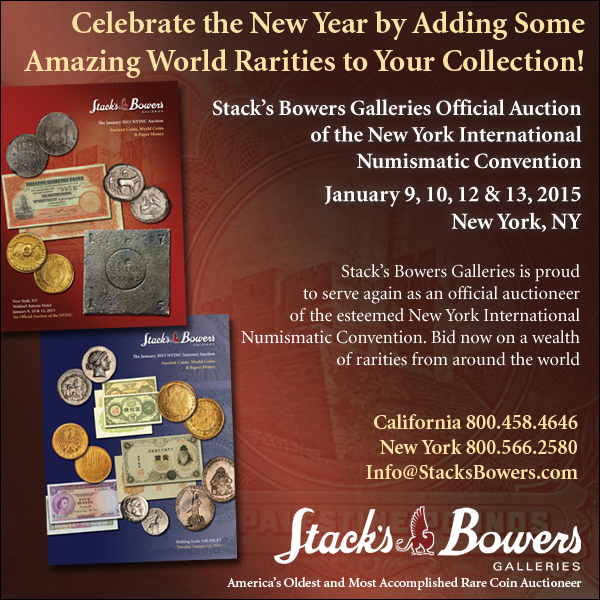
THE MEDALLIC WORK OF CHARLES CUSHING WRIGHT
CCW-44: Mapes Friendship Medal
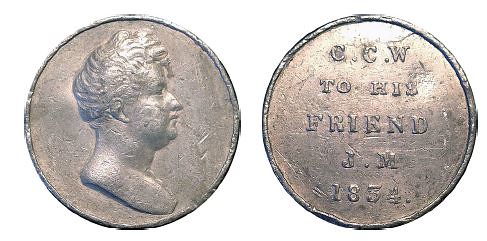
Listed in Bushnell in “An Arrangement of Tradesmen’s Cards ...” noted only in lead. Under Bushnell lot 387, “trial impression ... Lead, Unique ... The only impression from the die.” James Mapes was a well known chemist. Along with Wright, he was one of the founding members of the National Academy of Design. He assisted in the development of an ink used with Wright’s steel pen. His son Charles was a partner of Wright in the pen manufactory. In 1844 he was elected president of the Mechanics Institute of New York. (Wright created a medal for the institute circa 1834). His daughter was Mary Mapes Dodge, creator of the Hans Brinker stories. Isaac F. Wood noted that Wright created a die of Washington based on a drawing by a six year old Mary Mapes, to be described in the next issue.

CCW-48: New Haven Bicentennial Medal
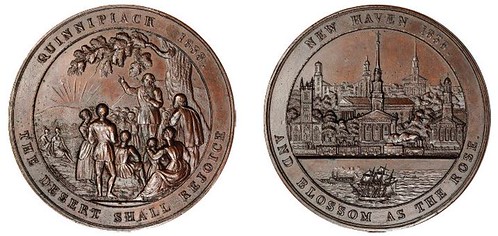
Obverse: A group of settlers and Indians being preached to below the limb of a tree. The sun’s rays in the background. Around the outside on a raised band THE DESERT SHALL REJOICE at bottom, QUINNIPIACK 1638. at top. In small letters above the DES of DESERT, c. c. wright.
Reverse: A scene of the city, a train moving from left to right, ships sailing left in the canal. On a raised band, NEW HAVEN 1838. is at the top, AND BLOSSOM IS THE ROSE. is at the bottom,
Edge: Plain
CCW-52: Zachary Taylor Medal
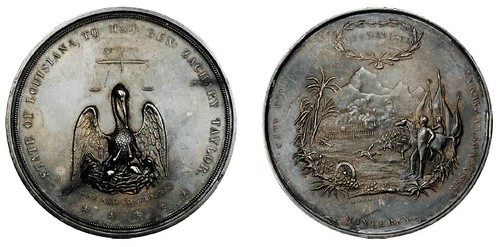
Obverse: A brown pelican, state bird of Louisiana perched on a nest, at center with a scale above its head and the word JUSTICE. Below, UNION AND CONFIDENCE. Around the central design, STATE OF LOUISIANA TO MAJ. GEN: ZACHARY TAYLOR. with six stars. In small letters at the base c. c. wright sculp. at left and p.p. duggan del. at right. Beads around the perimeter.
Reverse: A view of the battlefield. In the foreground, Taylor stands by his horse with his hat in his left hand just off to the right. The list of battles at left, top, right and bottom as follows: PALO ALTO, BUENO VISTA (this surrounded by a wreath), RESACA DE LE PALMA., and MONTEREY. In small letters below the battle scene h. f. baldwin & co. pub: n. o.
Edge: Plain
CCW-58: Will Page Medal
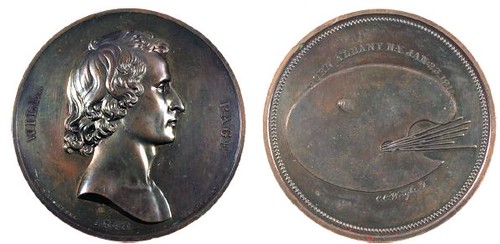
Obverse: Nude bust of Page facing right. WILL at left PAGE at right, 1848 below. c. c. wright fec: in small letters at left bottom rim. s. ellis del. in small letters at right bottom rim.
Reverse: On a plain field with a decorative border, an artist’s palette, with BORN ALBANY N. Y. JAN. 23, 1811 above. C.C. WRIGHT in script below.
Edge: Plain
William Page was an American painter born in Albany, NY in 1811. He moved to New York City to study law in about 1825 but left this to pursue art. In 1826, he enrolled in classes at the National Academy of Design and became a student of Samuel F. B. Morse. No doubt he and Wright were friends from the Academy. Page died in 1885.
CCW-62: Winfeld Scott Medal
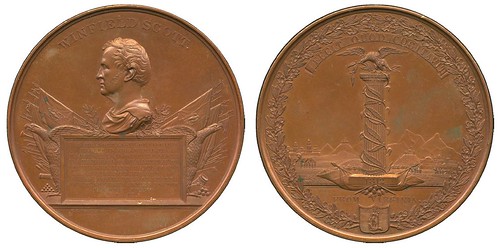
Obverse: A memorial plaque bearing the ten line inscription, THE COMMONWEALTH OF VIRGINIA / PRESENTS THIS MEDAL TO / MAJOR GENERAL WINFIELD SCOTT / AS A MEMORIAL OF HER ADMIRATION / FOR THE GREAT AND DISTINGUISHED / SERVICE OF HER SON / WHILST COMMANDER IN CHIEF / OF THE AMERICAN ARMIES IN THE / WAR WITH MEXICO / 1847. The plaque sits in front of a display of military arms with crossed flags, oak and olive branches and eagles at each side. Above the plaque sits a draped bust of Scott facing left. Above the bust WINFIELD SCOTT. In small letters in exergue, c. c. wright f.
Reverse: A closed wreath of oak and olive branches held at the base by the state seal of Virginia. In the background is a view of Mexico City in the control of the American army. A large column sits at the center. At the base are the words FROM VIRGINIA, while at the top an eagle sits with a garland of laurel in its beak wrapping around the column. On each leaf in small letters is the name of a battle, vera cruz, cerro gordo, contreras, churubusco, del rey, chapultepac, with 1812 below. At the top 1848 MEXICO. A ribbon above with the words FECIT QUOD COGITAVIT. In small letters at left ground line c. c. wright f.
Edge: Plain
FECIT QUOD COGITAVIT - is roughly translated “He accomplished what he set his mind to.”
CCW-68: Pennsylvania Horticultural Society Medal
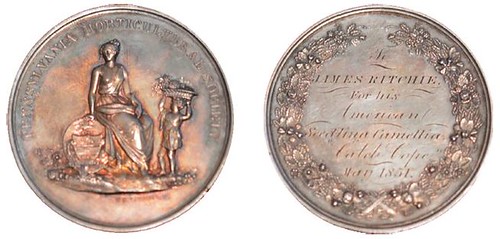
Obverse: A child presenting a basket of fruit to the seated figure of Demeter, goddess of the harvest. At her right shield with the state arms of Pennsylvania, and a ribbon with the state motto below, virtue, liberty independence. The legend, PENNSYLVANIA HORTICULTURAL SOCIETY around. c. c. wright f. in small letters below.
Reverse: A wide ornamental wreath of leaves and fruits of the harvest open at the top. Interior engraved with name of recipient, date and what the award is for.
Edge: Plain
For more information on the Medal Collectors of America., see:
www.medalcollectors.org
THE MISSING MISSOURI GOLD SALES TAX TOKENS
In 1937, the Scovill Mfg. Co. presented gold One and Five Mill Missouri Sales Tax Tokens to Director of Sales Tax George H. Bates and State Auditor Forrest Smith, in recognition of Scovill being chosen as the manufacturer of the new Missouri zinc tokens. They’d look like this, only gold.
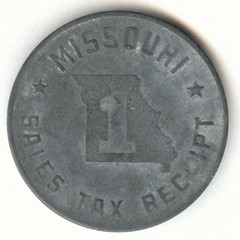
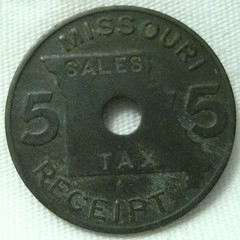
No one has seen one since 1964. Here’s what I know:
- A One Mill example was reportedly stolen from noted numismatist Eric P. Newman on Oct. 11, 1964, and was never recovered.
- Forrest Smith died in 1962; G.H. Bates died in 1978. Smith had 2 daughters; Bates had 2 sons and a daughter.
- The archivist at Scovill shows no record of the event. So far, I have found no records of them at the ANA library or the Missouri Archives.
If you have any information that could lead to the whereabouts of these gold sales tax tokens, please contact me.
Kevin Barnett
17404 Hilltop Ridge Dr.
Eureka MO 63025
eldeaco@yahoo.com
314/640-9091
American Numismatic Assn. member #175371
SLNA member # 1595

Archives International Auctions, Part XXI
Hong Kong 4
Rare Chinese, Asian & Worldwide Banknotes, Coins and Scripophily.
Highlights include:
- Mercantile Bank of India, 1948 Specimen Banknote Rarity
- Deutsch-Asiatische Bank, 1907 "Peking Branch" Issue Banknote
- China, 1932, $1, L & M-108 Y-344, Birds Over Junk
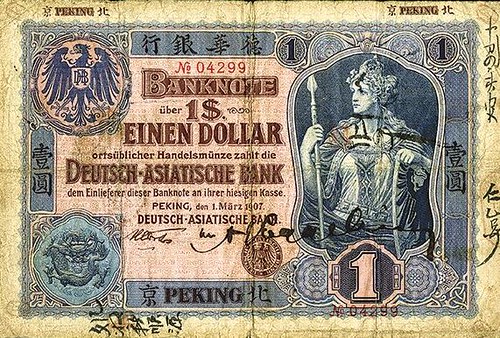
1580 Lemoine Avenue, Suite #7
Fort Lee, NJ 07024
Phone: 201-944-4800
Email: info@archivesinternational.com
WWW.ARCHIVESINTERNATIONAL.COM
ARE ISIS COINS BEING MINTED IN CHINA?


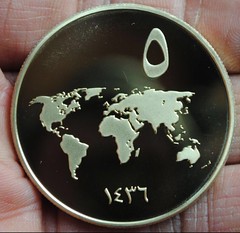
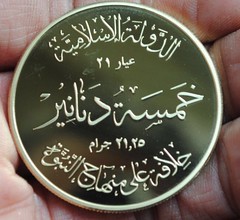
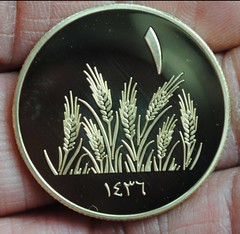


To read the earlier E-Sylum articles, see:
ISIS TO ISSUE ITS OWN COINAGE? (www.coinbooks.org/esylum_v17n47a25.html)
COIN WORLD: ISIS COINAGE IMPROBABLE (www.coinbooks.org/esylum_v17n48a22.html)
THE FUTURE OF CUBAN NUMISMATICS
Cuban Numismatic Association President Emilio Ortiz says the implications of President Barack Obama’s plan to rethink U.S.-Cuba relations are not yet clear, but if and when importing Cuban coins to the United States becomes legal, it would be a boon to that corner of the numismatic marketplace.
“The hobby of Cuban collectors and Cuban material will grow exponentially because simply there’s a wider base of collectors and more availability and product,” Ortiz said. “It would be an easier flow of commerce.”
President Obama announced a plan on Dec. 19 to “end our outdated approach” toward relations with Cuba and ease some of the travel, diplomatic and economic sanctions that have been in effect since 1962.
The administration doesn’t directly address numismatic items on the White House website, but it has a statement on the site regarding traveler commerce in general. Licensed U.S. travelers under the new policy can bring back $400 worth of Cuban goods.
Only Congress has the authority to formally and entirely lift the Cuban embargo, which is where Ortiz’s concerns come in.
“The issue here is where and how does dealing with the Cuban numismatic material fall” under U.S. trading restrictions, Ortiz said.
Embargo regulations ban the importing of Cuban coins and paper money issued since 1962.
Ortiz said that with regard to Cuban numismatics in the United States, the 500-pound gorilla in the room remains eBay.
The popular online auction site went above and beyond embargo regulations in 2013 to prohibit the sale of all Cuban coins and paper currency, including items issued before 1962, which are legally brought into the United States and collected.
“When they pulled [Cuban items] out of the auction process, they really sucked the wind out of the Cuban Numismatic Association and everybody that collected Cuban material,” Ortiz said.
Coin World has reached out to eBay several times for comment, but the company has not yet addressed the subject.
To read the complete article, see:
Market
for Cuban numismatic items would grow 'exponentially' with U.S. policy change
(www.coinworld.com/insights/coin-world-cuba-embargo-numismatics-world-coins-collecting-hobby-ebay-cuban-numismatic-association.html#)
THE BOOK BAZARRE
NORMAN COIN HOARD UNCOVERED IN BUCKINGHAMSHIRE
 Metal detector enthusiasts in Buckinghamshire have uncovered what is thought to be one of biggest hoards
of ancient coins ever found in Britain.
Metal detector enthusiasts in Buckinghamshire have uncovered what is thought to be one of biggest hoards
of ancient coins ever found in Britain.
Paul Coleman from the Weekend Wanderers Detecting Club discovered more than 5,000 coins buried inside a lead bucket two feet under a field near Aylesbury.
The hoard contains specimens dating back to the 11th Century - the late Anglo Saxon, early Norman period.
The coins will now be examined by the British Museum.
Mr Coleman, from Southampton, was taking part in a dig in the Padbury area on 21 December when he found the 5,251 coins depicting the heads of kings Ethelred the Unready and Canute.
A spokesman for the national club said those on the dig had "agreed this was the most exciting day of their detecting lives".
Peter Welch, who was at the dig, said Mr Coleman had seen some fragments of lead, picked off the top one and saw the "layers of coins".
"He didn't touch them, he knew it was important," he said.
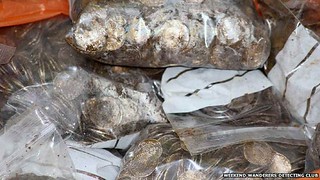 Mr Welch, who was immediately notified, said he was "shellshocked" when he realised
"it was real".
Mr Welch, who was immediately notified, said he was "shellshocked" when he realised
"it was real".
"There was general silence and a sharp intake of breath of the people watching," he said.
"This is something you dream of witnessing, let along digging up.
"They looked almost uncirculated, like they were straight from a mint."
The old Buckingham mint would have been within a day's walking distance so a possible link with that will be explored, he said.
The coins have been taken to the British Museum and a coroner must now rule if they are "treasure" under the Treasure Act.
A museum could then buy them with the proceeds being split between the landowner and the finder.
To read the complete article, see:
Thousands of ancient coins discovered in Buckinghamshire field
(www.bbc.com/news/uk-england-beds-bucks-herts-30654568)
To read the complete article, see:
Amateur treasure hunter finds £1million hoard of 1,000-year-old Anglo Saxon coins - after a whip-round for petrol to get there
(www.dailymail.co.uk/news/article-2893568/Amateur-treasure-hunter-finds-1-000-year-old-hoard-Anglo-Saxon-coins-worth-1million-buried-farmer-s-field.html)
Philip Mernick adds:
The coins are now at the British Museum and it will probably be Gareth Williams' job to sort them into neat piles by king and mint. Only then will we know if they are locally made (rare) or from a major mint such as London or Winchester (more likely). If that is the case then most of them will probably be declined by the BM and will finish up on the market in a year or so.
5000 + odd coins is roughly the equivalent of 25 pounds of silver so it could have been a tax levy or a danegeld payment that went astray, or possibly a merchant's hoard like the two similar lead containers found in post-conquest Colchester.
The article has an image of six of the coins as well as a link to a video of the coins being dug up. "Very unusual and well worth looking at," write Philip. -Editor
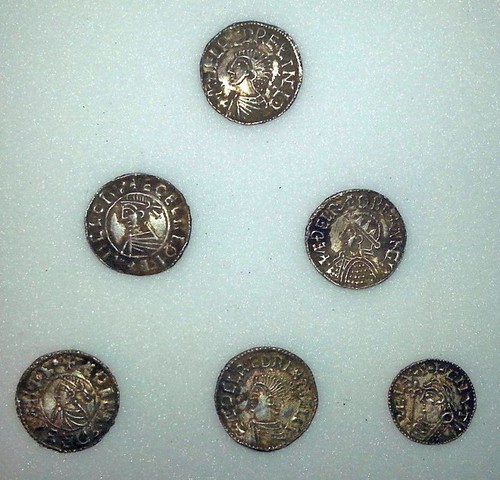
To read the complete article, see:
Treasure hunters find Anglo-Saxon
silver coins worth £1m in Buckinghamshire (www.ibtimes.co.uk/treasure-hunters-find-anglo-saxon-silver-coins-worth-1m-buckinghamshire-1481600)
ISRAEL RECOVERS 800 STOLEN ANCIENT COINS
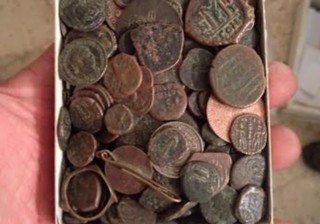 A
routine security check turned into a veritable treasure hunt, when the Antiquities Authority discovered a Beit Shemesh man had in his possession
hundreds of ancient coins and artifacts, the organization announced Wednesday.
A
routine security check turned into a veritable treasure hunt, when the Antiquities Authority discovered a Beit Shemesh man had in his possession
hundreds of ancient coins and artifacts, the organization announced Wednesday.
According to the authority’s Robbery Prevention Unit, the unidentified man, who is in his 50s, was initially detained last Wednesday at an antiquities site in the Beit Shemesh area, when police determined he was carrying digging tools in his bag.
The man denied he was searching for antiquities and claimed to know nothing about ancient coins. However, a subsequent search of his home later that evening uncovered roughly 800 bronze coins, ancient bronze objects, jewelry and metal cleaning equipment, the authority said.
“Among the coins found in the suspect’s home and identified by Antiquities Authority researchers were Persian coins from the 5th century BCE, and the Hellenistic, Roman, Byzantine and Ottoman periods,” the Robbery Prevention Unit said in a statement.
“The coins were seized and taken for evidence,” it continued.
Upon further questioning, the suspect confessed he was searching for the ancient coins using a metal detector, the authority said.
Dr. Ethan Klein, deputy director of the Robbery Prevention Unit, said searching for coins at ancient sites is a serious criminal offense.
“Ancient coins provide archeologists with important information from history,” Klein said. “The most comprehensive information is embedded in them, including the date, name of the ruler at the time, and place of production.”
“Displacing ancient coins causes irreparable harm and does not allow the recovery of information, and actually erases an entire chapter of the history of the ancient site,” he said.
According to the Robbery Prevention Unit, damage to an archeological site is punishable by up to five years in prison.
To read the complete article, see:
Israel recovers 800 ancient
coins, jewelry stolen by Beit Shemesh man
(www.jpost.com/Israel-News/Israel-recovers-800-ancient-coins-jewelry-stolen-by-Beit-Shemesh-man-386238)
THE SPECIFIC GRAVITY TEST FOR COPPER, BRONZE, AND BRASS
I'm writing to you as I came across your very interesting pair of articles on copper alloys, specifically:
"What's Copper? What's Bronze? What's Brass? What's the Difference?"
-The E-Sylum: Volume 13, Number 10, March 7, 2010, Article 11
"More on the Difference Between Copper, Bronze, and Brass"
- The E-Sylum: Volume 13, Number 11, March 14, 2010, Article 9
I'm coming to this from a non-currency angle, as I have a burgeoning interest in bells and chimes, where the differing alloys of copper can apparently produce different quality sounds. My first thought, which I had before I read the first article, was to use a specific gravity test to tell the difference. Like the author of the first article, I found that it would be ambiguous at best. Even if one could perform the test to better than a percentage point, as the second author points out, the difference between brass and bronze is the alloying metal (zinc or tin, respectively). But because of their differing densities, you could not uniquely distinguish the two alloys.
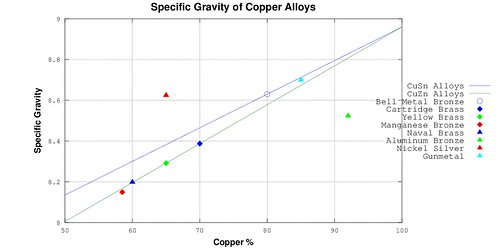
In order to help me think through the specific gravity test, I made the above chart, which may be of interest to others. There are two solid lines on the chart that show pure bronze (CuSn) and brass (CuZn) alloys specific gravities (vertical axis) as a function of copper percentage (horizontal axis). As you can see, depending on the copper content, you could have the same specific gravity for two different copper percentage brass and bronze alloys. I also included the specific gravity of some other copper alloys shown as a circle for bell metal bronze and diamonds and triangles for various other alloys as defined by Wikipedia. See: http://en.wikipedia.org/wiki/List_of_copper_alloys .
The other thing that struck me was this comment :
"What we need is a small, inexpensive device which can identify several different metals using a non-destructive method. The jewelry industry has two or three different kinds of hand-held devices for determining whether a diamond is real. We need something like that"
I immediately thought of x-ray fluorescence, which I am somewhat familiar with from my day job. It is non-destructive, and more than capable of giving metal compositions for the elements of interest for most metal alloys. I also knew that the components for these systems were produced for commercial purposes. A quick internet search turned up this product which might fit the bill : http://www.olympus-ims.com/en/xrf-xrd/delta-handheld/delta-alloy/ .
One limitation of this method is penetration depth of the x-rays. I haven't done a calculation yet, but it would only return an analysis based on the first centimeter at a guess. It also only illuminates a small area of the sample. Perhaps this measurement combined with a specific gravity test would give confidence on the composition of an entire object. I am pursuing the x-ray angle for my own entertainment.
To read the earlier E-Sylum articles, see:
WHAT'S COPPER? WHAT'S BRONZE? WHAT'S BRASS? WHAT'S THE DIFFERENCE?
(www.coinbooks.org/esylum_v13n10a11.html)
MORE ON THE DIFFERENCE BETWEEN COPPER, BRONZE AND BRASS
(www.coinbooks.org/esylum_v13n11a09.html)
NUMISMATIC VOCABULARY: BRONZE VS BRASS (www.coinbooks.org/esylum_v15n11a10.html)
ON BRASS, BRONZE, AND GOLDENE (www.coinbooks.org/esylum_v15n12a18.html)
QUERY: WHAT IS THE DEFINITION OF BRONZE (www.coinbooks.org/esylum_v17n45a10.html)
ANSWERS: WHAT IS THE DEFINITION OF BRONZE? (www.coinbooks.org/esylum_v17n46a08.html)
THE BOOK BAZARRE
MORE ON THE ANTICHRISTIAN CONFEDERACY
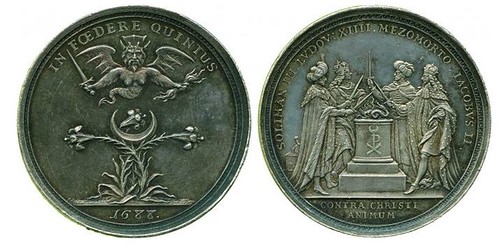
James II (1685-1688), Antichristian Confederacy 1688, Silver Medal by J Smelzing, standing figures of Suleyman III of Turkey, Mezzo Morto of Algiers, Louis XIV and James II swear an oath of allegiance around an altar, SOLIMAN III. LUDOV: XIIII. MEZOMORTO. IACOBVS II., in exergue CONTRA CHRISTI ANIMUM, rev an imp wearing a Jesuit’s cap, hovering above lilies and a crescent, brandishes a sword and thunderbolt, IN FOEDERE QUINTUS, in exergue 1688, 37mm (Eimer 295; MI i 632/54). Extremely fine, rare.
Ron Haller-Williams writes:
The four rulers are pledging an alliance with their swords, on an altar ("the altar of discord"), with a (fiery?) serpent amid the altar flames, "against the spirit/mind/soul of Christ"; we see that the "chi-rho" is distorted, and surmounted by a (Moslem) crescent.
On the other side we have 3 lilies (representative of the 3 fleurs-de-lys of France), again supporting the crescent: above, the devil is "the fifth one in the league/federation" - in place of where the sun would be. (This is a reference to "le roi soleil" or "the sun king" as Louis XIV was known.) The devil has a sword & thunderbolt (attributes of Jupiter, subsequently also used in regard to God). The Jesuit's cap (worn by this devil) should leave us in no doubt that the medal is a dig at Catholics.
The Dutch Protestants would of course have been rather negative not only about Louis XIV but also the (Catholic) James II - especially with their Statholder Willem III ready to supplant James II when "invited" to do so, as happened later that year. Note that he and his wife Mary, a daughter of James II, were both grandchildren of Charles I.
ANS Medallic Exhibition March 1910
It was rumoured in Holland that a secret treaty had been concluded between James and Louis XIV. called " The French league to cut Protestants' throats in England," and also that James had allowed some Algerine Corsairs to carry Dutch prizes into English ports. Like- wise Louis was accused of exciting the Turks against the Germans. As illustrating these rumours these four potentates are represented as leaguing together against Christianity, the devil being a fifth conspirator.
To read the complete article, see:
Full text of "International medallic
exhibition of the American Numismatic Society, opening on the twelfth of March, 1910. Catalogue"
(http://archive.org/stream/internationalme00socigoog/
internationalme00socigoog_djvu.txt)
The medal was also used in a footnote in a 1970 book about early poetry:
Alastair Fowler, Triumphal Forms; Structural Patterns in Elizabethan Poetry

To read this in context, see https://books.google.co.uk/books?id=4-0zvIngXDkC&pg=PA77
And for more information about this book, see: https://books.google.co.uk/books?id=4-0zvIngXDkC
However, very far from being in alliance, "the French fleet bombarded Algiers again in 1688, and Mezzomorto retaliated with attacks on the French coast." (Wikipedia article on Mezzo Morto).
Numismatic References
- Hawkins, Franks & Grueber, "Medallic illustrations of the history of Great Britain and Ireland to the death of George II" (1885) volume1 page 632 #54;
- Christopher Eimer, "An Introduction to Commemorative Medals" (Seaby, 1989) - not #295 but #177 (page 65 and plate 25)
- Gerard van Loon, "Histoire metallique des XVII provinces des Pays-Bas" (tome troisieme = 3rd volume, 1732), page 347 (3 sizes)
- Gerard van Loon, "Beschrijving van nederlandsche historie-penningen" (Derde Deel = 3rd volume, 1728), pages 371/372 (3 sizes)
- Montenuovo’sche Munzsammlungen (Count Montenuovo’s coin colletions), A. Hess Frankfurt am Main. (Auction dates: 22-26 Sept. 1880; 1885; 3 Nov. 1886 on.) lot 1087
- Piero Voltolina, "Storia di Venezia attraverso le medaglie", Volume 2 (1998) #1075
To read the earlier E-Sylum article, see:
COMMEMORATIVE MEDAL SELECTIONS FROM BALDWIN'S
(www.coinbooks.org/esylum_v17n52a24.html)
GOLD TEETH DROPPED IN SALVATION ARMY KETTLE
Len Augsburger writes:
For many years the Salvation Army has been finding gold coins in their kettles (if memory serves, Harlan Berk in Chicago has handled a few of these). There is a macabre twist this year.
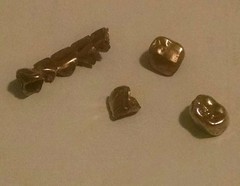 A set of gold teeth took a bite out of needed donations this year for the
LaPorte Salvation Army.
A set of gold teeth took a bite out of needed donations this year for the
LaPorte Salvation Army.
The gold teeth, crowns and a gold bridge given to a bell ringer helped the LaPorte Salvation Army shatter its previous Christmas kettle drive record, according to a group official....
To read the complete article, see:
Gold
teeth boost LaPorte Salvation Army donations
(www.nwitimes.com/news/local/laporte/gold-teeth-boost-laporte-salvation-army-donations/article_c802644a-9956-5f14-84f8-69481c9ea1b8.html)
FEATURED WEB SITE: CUBAN NUMISMATIC ASSOCIATION
This week's Featured Web Page is the Cuban Numismatic Association.Welcome to the Web site of the Cuban Numismatic Association, founded on January 9, 2004. The goal of the Association is to encourage, promote and disperse Cuban numismatic knowledge, culture, education and fraternal relations among the numismatic community.
The association is not affiliated with the Cuban Government Mint or the Association of Cuban Numismatics, based in Havana, Cuba.
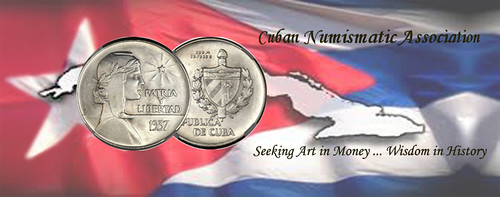
www.cubannumismaticassociation.com
